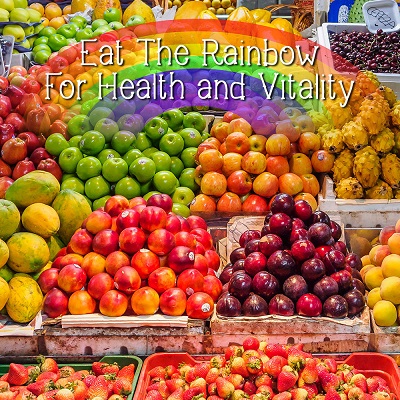 Dieticians and nutritionists have been heard to say, ‘Eat the rainbow.’ This saying is to remind us to eat plenty of fruits and vegetables regularly for good health and vitality. It signifies foods consisting of red, orange, yellow, green, blue, and violet or purple fruits and vegetables. They are low in calories and rich in fiber, minerals, and essential vitamins.
Dieticians and nutritionists have been heard to say, ‘Eat the rainbow.’ This saying is to remind us to eat plenty of fruits and vegetables regularly for good health and vitality. It signifies foods consisting of red, orange, yellow, green, blue, and violet or purple fruits and vegetables. They are low in calories and rich in fiber, minerals, and essential vitamins.
Adding fruits and vegetables with varied colors to your diet is not only an added attraction to your meals. They are great sources of flavonoids that lower your risk of cognitive decline, diabetes, and cardiovascular disease.
The rainbow color of foods helps you to consume the full range of flavonoid-rich foods. Flavonoid is the largest group of phytonutrients that can help prevent biological stress, known as oxidative stress, caused by free radicals which can adversely affect your health at a cellular level.
Phytonutrients provide unique health benefits. Every color has specific nutrients and corresponding benefits that help the body get healthy. Their antioxidants and anti-inflammatory properties neutralize free radicals to prevent cell damage.
Rainbow Fruits and Vegetables and Their Benefits
Each color of the rainbow represents different phytonutrients and health benefits. Below is a list of foods you can add to your diet so you can start eating the rainbow!
Red Fruits and Vegetables
These healthy foods have carotenoid pigments called lycopene that give them a red or pink color. Lycopene protects your body as it is a powerful antioxidant and anti-inflammatory. Eating red foods will lower your risk of heart disease by reducing oxidative stress caused by free radical damage. They help reduce bad LDL cholesterol and increase good HDL cholesterol levels too.
They aid in helping people with metabolic syndrome and protect against sun-related skin damage and reduce skin cancer risk. These red foods also contain other vitamins and minerals such as fiber, folate, magnesium, manganese, potassium, and vitamins A, B6, C, and K1.
Vegetables include beetroot, red bell pepper, red cabbage, jalapeno pepper, red chard, red chicory, kidney beans, and red onion. Fruits include tomatoes, apples, cherries, cranberries, grapes, lingonberries, nectarines, pomegranates, raspberries, red currants, red pears, plums, strawberries, and watermelon.
Orange Fruits and Vegetables
These foods get their orange hues from their carotenoids beta-carotene, which is synthesized as vitamin A in your body and is essential for eye health. They are rich in vitamin C, fiber, folate, and potassium. These orange-colored foods also support reproductive health.
Examples of carotenoid-rich fruits are apricots, butternut squash, cantaloupes, grapefruits, mandarin, mangoes, oranges, papayas, peaches, persimmon, pumpkin, sweet potatoes, and tangerines. Orange vegetables include carrots, orange bell pepper, and yam.
Yellow Fruits and Vegetables
These are excellent for your digestive tract because they are rich in probiotics. Probiotics stimulate your digestive system’s microbiota to create short-chain fatty acids, which are vital for overall health.
Yellow foods contain the same carotenoids as orange foods, which belong to the vitamin A group. They also boost eye health and cell growth.
Enjoy yellow fruits such as yellow-colored apples, bananas, golden raspberries, mangoes, lemons, loquat, pineapples, yellow pears, starfruits, and yellow watermelons. Eat yellow vegetables such as sweet corn, bell peppers, ginger, golden beets, maize, yellow onion, potatoes, summer squash, and yellow tomatoes.
Green Fruits and Vegetables
Your health will benefit greatly from eating green foods. They are filled with some of the major sources of essential nutrients, vitamins, and minerals, such as fiber, folate, magnesium, potassium, and vitamin A.
They will protect your heart from oxidative stress and prevent chronic diseases caused by inflammation. Green fruits and vegetables promote blood and bone health and are loaded with isoflavones, isothiocyanates, lutein, and vitamin K.
They are also linked with decreased risk of various types of cancer because they are packed with antioxidants.
Fruits include avocados, green apples, grapes, kiwi fruit, pears, limes, and olives. Choose cruciferous vegetables such as arugula, bok choy, broccoli, Brussels sprouts, cabbage, cauliflower, collards, kale, and watercress. Also include lettuce, spinach, swiss chard, green beans, green peas, and zucchini in your diet.
Blue and Purple Fruits and Vegetables
These fruits and veggies have either black pigments or deep reds and are delicious and nutritious additions to the rainbow diet. They are rich in phytonutrients anthocyanins and resveratrol. They have antioxidant properties and help protect against Alzheimer’s disease, cancer, and diabetes.
The anti-inflammatory properties are helpful for arthritis and skin inflammation. Their main vitamins and minerals are vitamins B6, C, and K1, plus fiber, manganese, and potassium.
Enjoy eating delicious blueberries, blackberries, elderberries, figs, purple-red grapes, plums, prunes, raisins, and purple sweet potatoes. Also include beetroot, turnips, purple potatoes, eggplant, red cauliflower, purple bell peppers, red onions, purple carrots, and purple lettuce varieties.
In Summary
You can become very creative and colorful in your kitchen. Preparing brightly colored dishes breaks the boredom too! Add two to three colorful fruits or vegetables to every meal and one or more to every snack. Combine them, top them off to dishes, or freshly mix them into salads.
Enjoy your breakfast with a combination of green, yellow, and red fruits and vegetables made as rainbow smoothies. Have an omelet filled with tomatoes, onions, and green vegetables.
Top your pizza with onion, red bell pepper, and broccoli. Add colorful vegetables to soups, and add them to stir-fries or casseroles. You can also prepare them as desserts and snacks, or simply eat a piece of fruit or two.
Incorporating the rainbow into your diet can boost your health due to the variety of nutrients. There are so many benefits to eating the rainbow!





